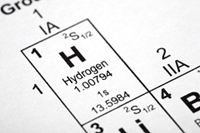Probing hydrogen under extreme conditions
13 Apr 2012
How hydrogen - the most abundant element in the cosmos - responds to extremes of pressure and temperature is one of the major challenges in modern physical science. Moreover, knowledge gleaned from experiments using hydrogen as a testing ground on the nature of chemical bonding can fundamentally expand our understanding of matter. New work from Carnegie scientists has enabled researchers to examine hydrogen under pressures never before possible. Their work is published online in Physical Review Letters.
 To explore hydrogen in this new domain, the scientists developed new techniques to contain hydrogen at pressures of nearly 3 million times normal atmospheric pressure (300 Gigapascals) and to probe its bonding and electronic properties with infrared radiation. They used a facility that Carnegie manages and operates at the National Synchrotron Light Source (NSLS) at Brookhaven National Laboratory in partnership with NSLS.
To explore hydrogen in this new domain, the scientists developed new techniques to contain hydrogen at pressures of nearly 3 million times normal atmospheric pressure (300 Gigapascals) and to probe its bonding and electronic properties with infrared radiation. They used a facility that Carnegie manages and operates at the National Synchrotron Light Source (NSLS) at Brookhaven National Laboratory in partnership with NSLS.
Observing hydrogen's behaviour under very high pressures has been a great challenge for researchers, because it is in a gas state under normal conditions. It is known that it has three solid molecular phases. But the structures and properties of highest-pressure phases are unknown.
For example, a transition to a phase that occurs at about 1.5 million times atmospheric pressure (150 Gigapascals) and at low temperatures has been of particular interest. But there have been technological hurdles in examining hydrogen at much higher pressures using static compression techniques.
It has been speculated that under high pressures, hydrogen transforms to a metal, which means it conducts electricity. It could even become a superconductor or a superfluid that never freezes - a completely new and exotic state of matter.
In this new work, the research team, which included Carnegie's Chang-sheng Zha, Zhenxian Liu, and Russell Hemley, developed new techniques to measure hydrogen samples at pressures above 3 million times normal atmospheric pressure (above 300 Gigapascals) and at temperatures ranging from -438 degrees Fahrenheit (12 Kelvin) to close to room temperature.






























